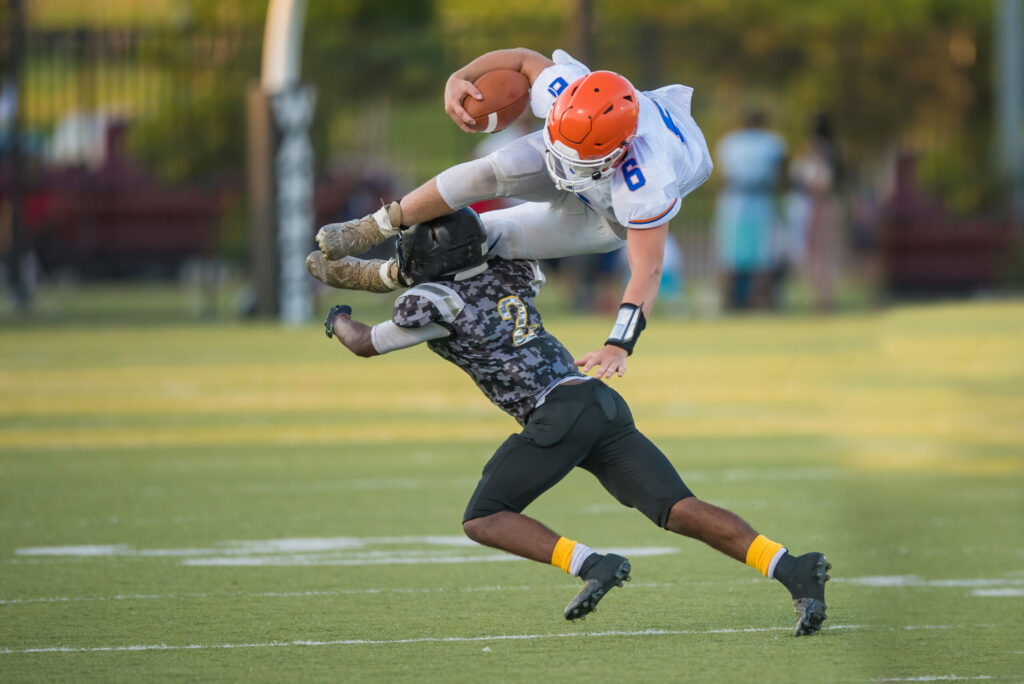Planning for fall sports safety at your school probably doesn’t take just one season. More accurately, it’s close to a year-round job working to ensure student-athletes are prepared for a safe and enjoyable experience.
Sports injury prevention and avoiding heat illness in sports are two of your biggest priorities and concerns. Here are the best practices and prevention tips you can use for a safer outcome this fall.
Fall Sports Safety Tips to Prevent Injuries & Heat Illness
 Recent research by the NCAA found that more than 1 million injuries occur yearly among college athletes, ranging from minor sprains to breaks and serious concussions. Fall sports like football, field hockey, and volleyball pose unique safety risks and can present a number of health challenges.
Recent research by the NCAA found that more than 1 million injuries occur yearly among college athletes, ranging from minor sprains to breaks and serious concussions. Fall sports like football, field hockey, and volleyball pose unique safety risks and can present a number of health challenges.
One of the most common hazards of fall sports is the risk of heat illness. Heat exhaustion, dehydration, and heat stroke can all occur if proper precautions are not taken.
Reducing the Risk of Heat Illness in Sports
When participating in practice or games outdoors, taking breaks to cool off and drinking plenty of fluids during warm weather are both important. But what is critical to be aware of during practice and games isn’t just the temperature—it’s the heat index.
According to the National Weather Service, the heat index is what the temperature feels like to the body when combined with the effects of humidity. It’s hard for perspiration to evaporate when there is too much humidity (moisture) in the air, which makes it hard for the body to control its temperature. This can cause heat-related illnesses.
There are three types of heat-related illnesses:
- Heat cramps are a type of heat illness that can cause painful muscle cramps and spasms. They typically occur during or after intense exercise and sweating in high temperatures.
- Heat exhaustion is a condition that is more severe than heat cramps. It is caused by dehydration and loss of salt in the body and usually happens in extreme heat and excessive sweating when proper fluid and salt replacement is not given. If left untreated, heat exhaustion can lead to heat stroke.
- Heat stroke is the most severe form of heat illness, which occurs when the body’s heat-regulating system is unable to cope with excessive heat. It is a medical emergency and should be treated promptly.
Heat disorders such as fatigue can start at heat index readings of 80-90, while heat cramps and heat exhaustion can appear between readings of 90-105. Heat stroke is possible between 105 to 130, while heat stroke is likely when 130 or higher with continued exposure.
 How to Prevent Heat Illness in Sports:
How to Prevent Heat Illness in Sports:
- Don’t get too much sun.
- Wear appropriate and light clothing and gear.
- Take frequent breaks in the shade.
- Stay well-hydrated.
If any signs of heat illness appear, it’s vital to move the student-athlete to a cool location, provide cold drinks containing sugar and salt, and immediately seek medical attention.
How to Prevent Sports Injuries
In addition to keeping student-athletes well-hydrated and staying on the lookout for heat illnesses, planning for fall sports safety also includes:
- Undergoing preseason physicals: Student-athletes should undergo a physical exam to ensure they are in good health or not suffering from any medical condition before beginning any program.
- Creating a fitness plan that incorporates cardiovascular exercise, strength training, and flexibility exercises to reduce injury risk.
- Requiring proper warm-ups and cool-downs: Doing stretching before and after physical activity can help reduce injury risk and prevent common exercise injuries.
- Providing and using proper safety equipment: Student-athletes should use the proper safety equipment, including helmets, face guards, pads, and other protective gear, to minimize the risk of serious injury.
- Following sports rules and any safety guidelines set by the governing body.
- Encouraging student-athletes to speak up about any pain they experience.
- Staying well-rested.
 Reducing the Financial Risk of Sports Injuries
Reducing the Financial Risk of Sports Injuries
To ensure that you and your team enjoy a safe fall sports season, it’s important to be aware of the risks and to take sports injury prevention precautions like those included here.
But if the unfortunate occurs and a student-athlete is injured, prompt medical attention can make the difference. Families and players will appreciate the help of accident insurance, like plans offered by A-G Administrators, to help alleviate the financial risk associated with accident medical care by covering out-of-pocket expenses left by primary health insurance.
If you’d like to learn more about how an A-G Administrators’ sports accident plan works, we would love to talk to you. Just complete this form. And, if you’d like to learn about the most common athletic injuries, their impact on programs, and how your school compares to its peers, download this complimentary study.

 Recent research by the NCAA found that more than
Recent research by the NCAA found that more than  How to Prevent Heat Illness in Sports:
How to Prevent Heat Illness in Sports: Reducing the Financial Risk of Sports Injuries
Reducing the Financial Risk of Sports Injuries
